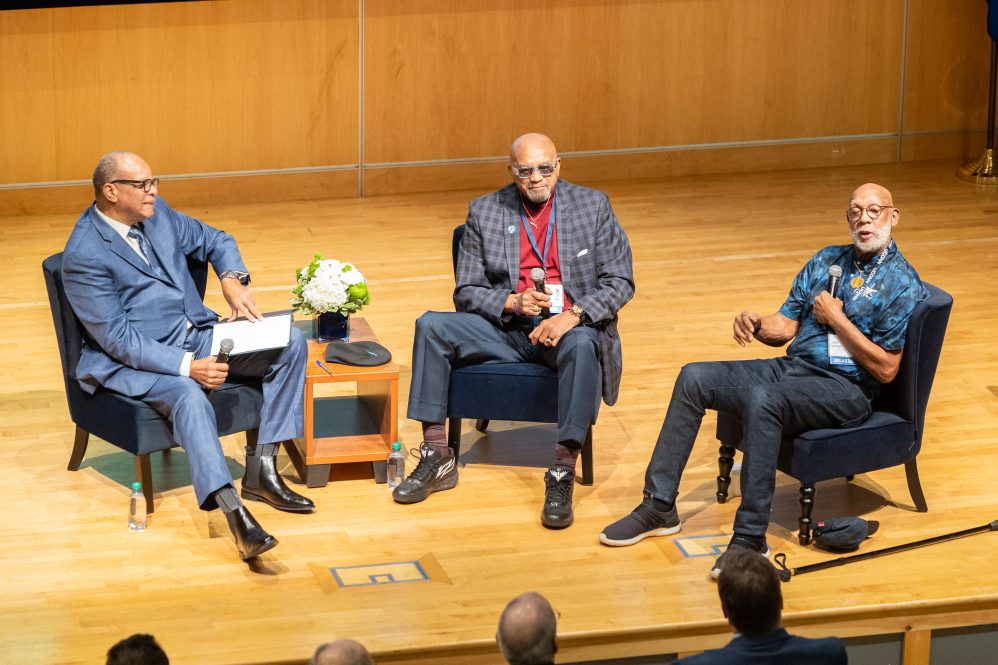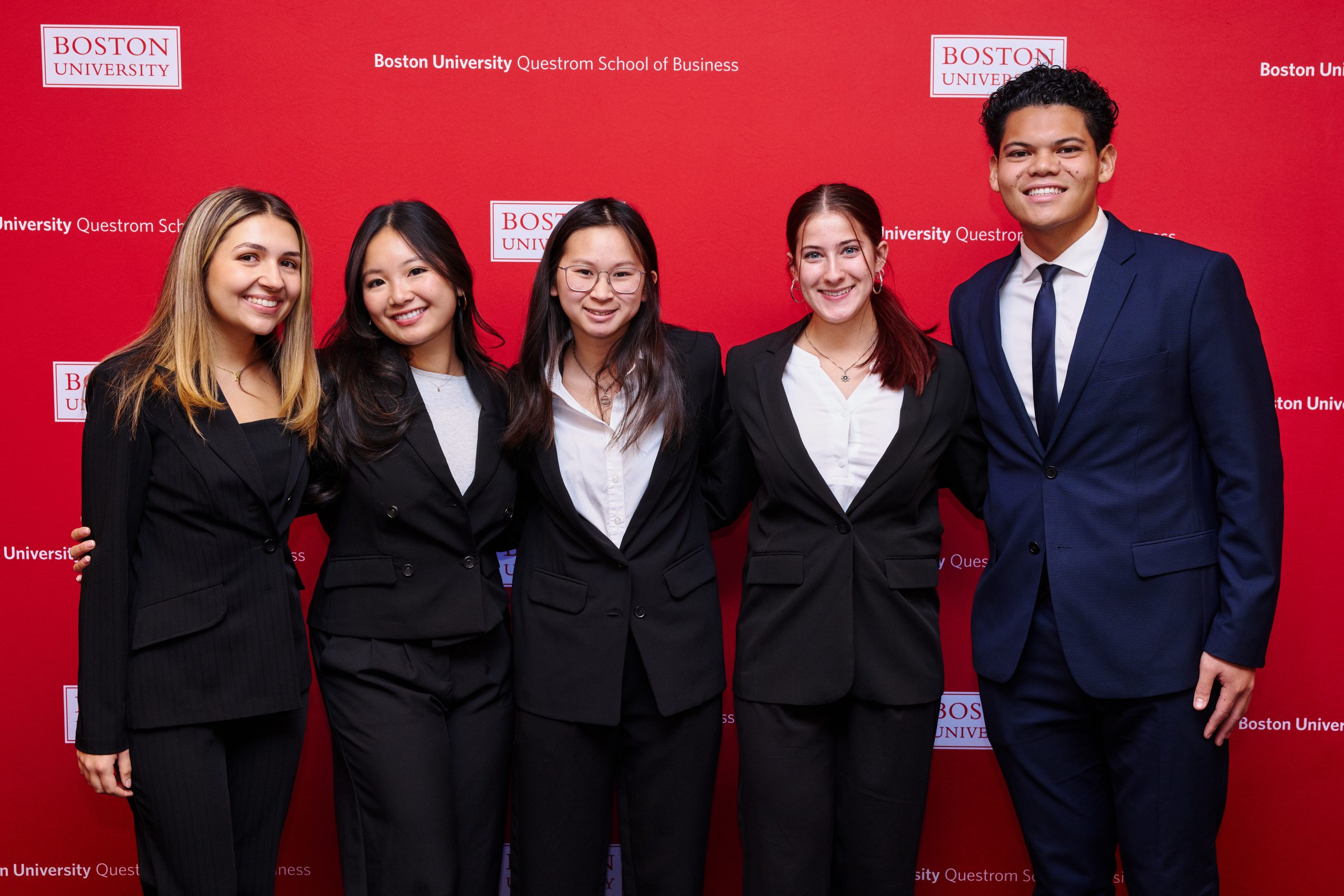John Carlos doesn’t want applause.
He told a packed house in the Student Union Theatre as much as he sat on stage beside his fellow former Olympian, Tommie Smith, and the Hall of Fame sports journalist William C. Rhoden on the Wednesday-night opening of the second Human Rights Summit at UConn.
Carlos and Smith were welcomed to the Student Union stage with applause, some audience members standing in appreciation of the pair’s appearance. Carlos was quick to shut that down.
“I don’t like applause,” Carlos said. “I’m not doing a soft-shoe dance. I’m not up here trying to sing. I’m up here trying to make a connection.”
He sought that connection at UConn from the approximately 400 people in attendance at the summit event, whose welcome of the two Olympians stood in stark contrast to the reception the pair received 57 years before, as young athletes receiving medals on an Olympic podium in Mexico City.
A video clip from Smith and Carlos’s iconic protest at their medal ceremony at the 1968 Olympic Games projected above them showed them both as young men, each wearing a black glove and no shoes, standing on the podium as the National Anthem played, their hands raised over their heads.
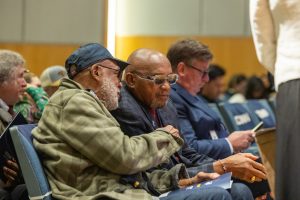
As the medal ceremony ended and Smith and Carlos left the podium, their Olympic audience booed and jeered.
“Every time I see that clip, I still get goosebumps,” remarked Rhoden.
The period leading up to the 1968 Olympics was marked by widespread unrest. The Vietnam War and the anti-war movement were ongoing, as was the Civil Rights Movement. That April saw the murder of Martin Luther King, Jr., followed by the assassination of Robert F. Kennedy a little more than two months later.
Many Black athletes felt a deep sense of anger and frustration, and many called for a boycott of the Olympics, but the U.S. participated nonetheless. Both standout track athletes at San Jose State University at the time, their decision to protest came before any events were run, but Smith and Carlos each approached their decision from a different standpoint.
“I didn’t come for the medal,” said Carlos. “I came to make a statement.”
“I came to win the race,” said Smith, knowing that winning would give him a visible platform for his demonstration. “You’re looking at two guys who are very different, but socially, we stand for the same thing…We knew we had a responsibility. My responsibility came through speed.”
While their protest was planned, the backlash they’d face over the next decade was beyond what they could have ever predicted. They were expelled from the Olympic Village and denounced by the International Olympic Committee. They and members of their family were targeted and denied employment and schooling, they said.
“You went out that morning and the sun was shining,” Carlos said, “and then it’s nothing but lightning and thunder.”
But even with hindsight, Smith and Carlos told the UConn audience that they wouldn’t change their decision to protest that day.
And their decision still resonates decades later, in a polarized world where athlete protests still make global headlines, said summit co-organizer James Waller – the Christopher J. Dodd Chair in Human Rights Practice and director of Dodd Human Rights Impact Programs at UConn.
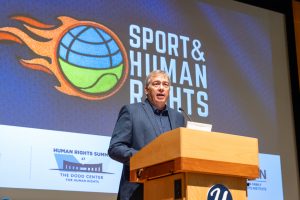
“That moment…lasted less than 9 seconds,” said Waller. “And even though not a word was uttered, that moment has reverberated for the past 57 years.”
Both Smith and Carlos urged those in attendance, regardless of race – and especially the large number of UConn students – to find connections with those around them and to take whatever action they can, large or small, to work toward greater equity and to fight against ongoing injustices in our society, not just for themselves but also for the generations to come.
“Anything you do right now should be concerned with what kind of world you’re leaving for your kids,” Carlos said.
“You don’t have to rule the world, or to make big claims, to do something,” Smith said. “Just step up. Whatever you think is right, make strides toward those efforts.”
Race, Gender, and Money
The conversation with Smith and Carlos opened a multi-day summit examining issues at the intersection of sports and human rights – a topic uniquely suited to UConn, according to University President Radenka Maric.
“There is no better place to have this summit than UConn,” said Maric. “The relationship between sports and human rights is both timely and perfectly suited to UConn because of our proud tradition of athletics and success.”
Home to the Gladstein Family Human Rights Institute, UConn is also a premiere university working to advance human rights knowledge and practice through research, teaching, and engagement.
On its best days, according to Waller – a former college athlete, and now an internationally recognized scholar on the Holocaust and genocide studies – sports are anchored in human rights values.
“Sport promotes fairness, nondiscrimination, respect, and equal opportunities for all,” he said. “On its worst days, however, sport can fail to uphold these standards. Instead of promoting and protecting human rights, sport can reveal serious violations of human rights – including racial and sexual discrimination, financial exploitation, and neglect and curtailment of participatory rights and freedom of expression.”
And the second day of the summit picked up where Wednesday’s keynote left off, as Waller was joined by the award-winning sports journalist and podcast host Pablo Torre for a wide-ranging conversation that touched on the ways that race, gender, and especially money, all affect human rights in sports.
“The answer to all of your questions is money,” Torre told the packed early-morning crowd at The Dodd Center’s Konover Auditorium.
From professional football and NBA team ownership to sponsorship patches on sports jerseys, money plays a significant role in visibility and the normalization of companies and personalities – and even bad actors – through sports.
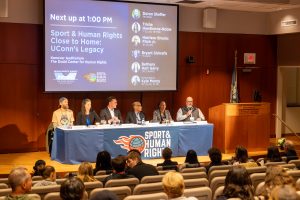
“Everybody has a number,” Torre said. “It turns out that the number might not be as high as you might have hoped.”
Torre also discussed how trans athletes in sport have become a touchpoint for right-leaning personalities, a theme continued in the second conversation of the day, which focused on gender.
“When we think about fairness, that is a very heavy word right now,” said Anna Baeth, a sports sociologist and activist with Athlete Ally, “and that is because it has been co-opted by politicians to talk about trans athletes.”
Oftentimes, explained Amira Rose Davis, an historian and assistant professor at the University of Texas-Austin, concepts we’re grappling with today have their roots in very old foundations.
“We’re asking ‘how did we get here?’ and ‘why is it like this?’ Well, because it was set up like that, sixty years ago,” Davis said. “When we’re talking about inclusion, when we’re talking about the meaning of sport, a lot of this is asking us to explain what values we attach to sport and why. Inclusion into what?”
Sports, said the best-selling author, trans athlete, speaker, and educator Schuyler Bailar, are reflective of the society we’re in.
“They always have been, and I think they always will be,” Bailar said. “Can they lead us forward? Sure…they’re an expose, an expression, a performance of society.”
Setting policies around gender and inclusion in sport is important, but how we interact with each other, and how we prioritize someone’s gender over other values in our interactions contributes to society’s values.
“I don’t think we can just set policy in sports and say, ‘That’s going to fix this problem,” Bailar noted.
Seizing Opportunities
The final day of the summit opened with an exercise led by keynote speaker Dannelle Umstead, the Paralympian ski racer and three-time Paralympic bronze medalist.
Audience members closed their eyes, imagining careening down a mountain at 50 miles per hour, with only the voice of a guide to help them navigate their way down.
Umstead began losing her vision as a child. After her mother passed away, her vision worsened, she lost a job that she loved, and saw her independence slipping away from her. One day, her father took her skiing, which changed the trajectory of her life.
“We skied that entire day,” she recounted. “I realized, for the first time since all my losses, I didn’t think about my mom. I didn’t think about my job that I lost. All I thought about was pure joy.”
Umstead was 29 years old when she and her future husband and ski guide moved to Park City, Utah. She didn’t try to make her first Paralympic games until she was 38 years old.
“Most athletes my age have retired by now,” she said, citing the dual challenges she faced in a world that doubted her abilities as an athlete not just because of her disability but also because of her age.
Umstead medaled in two events at her first Paralympic games in Vancouver 2010, then medaled again in Sochi 2014 following a diagnosis of multiple sclerosis that forced her to relearn how to walk and ski again.
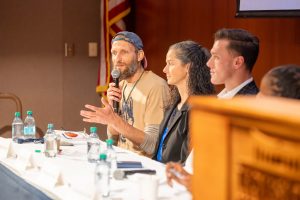
Her keynote was followed by a panel discussion with scholars and entrepreneurs on the complex intersections between sports, corporate power and human rights.
The global sports market is valued at $2.65 trillion, including sports participation, product, and fan engagement, noted Ginous Alford, a social entrepreneur and director of sport and human rights with the World Players Association.
“Where there’s value creation, you also have to talk about where there will be value extraction,” said Alford. “Many industries, sport included, have externalized those costs, and we’re talking today about how many of those costs are human. We see workers, local residents, journalists, fans, and especially athletes – the ones who generate the spectacle themselves – that their risks are risks that they did not choose or design.”
At UConn, students drove the effort to ensure that the University’s commercial partners adhered to wage and labor standards in the production of their products that aligned with the University’s priorities and commitments to human rights, explained UConn’s director of brand partnerships and trademark management Kyle Muncy ’92 (CLAS) ’22 MBA.
“Today, UConn is universally regarded as the standard for institutional and industry-wide engagement in the area of licensing merchandise oversight and management,” Muncy said, and the policies that the University has instituted help protect over a million workers at 3,500 factories in 48 countries around the world.
“Not every university is doing that work,” he said, “but every university is benefitting from that work.”
As are professional sports leagues and other organizations and institutions that have the same licensees and partners and rely on the same global supply chain for their merchandized products.
Sport is often seen as an entity that can regulate itself, explained Daniela Heerdt, a researcher and independent consultant in the field of sport and human rights for the Centre for Sport and Human Rights, but that view raises challenges.
“We have frameworks and tools and concepts to help sport not put commercial interests and cost above human rights,” Heerdt said, including the U.N. Framework for Business and Human Rights, and though progress has been incremental, some sporting bodies have begun to incorporate human rights principles into their policies.
“It’s not about making sport responsible for all the terrible things that are happening in a host city, for example,” she said, “but it’s really about helping sports understand where we can have positive impact and seizing these opportunities to protect and respect human rights.”
In the Details
The summit concluded with a panel featuring UConn alumni and former athletes – including including former men’s basketball star Doron Sheffer ’96 (BGS); Bethany Hart Gerry ’00 (CAHNR), Olympian and UConn All-American; and former UConn football quarterback Bryant Shirreffs ’17 (BUS) ’18 MS – who discussed some of their own personal experiences in college and beyond, and how those experiences shaped their own views of human rights in sports.
Harrison Brooks Fitch, Jr. ’64 (CLAS) – son of the late Harrison “Honey” Fitch, UConn’s first Black basketball player – recounted how his father overcame the racial inequalities of the 1930s as a three-sport athlete and received the support of his fellow athletes and students at what was then called Connecticut State College.
At UConn, Fitch’s legacy has been memorialized through the Harrison Fitch Leadership Fund, established in 2022 to provide fellowships for students from underserved communities who demonstrate leadership qualities and the potential for future success.
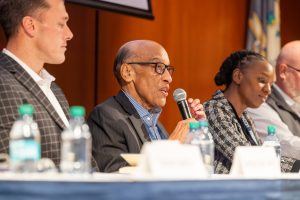
Trisha Hawthorne-Noble ’11 (CLAS) ’18 MSW, a researcher, senior director of student activities at UConn, and former standout track athlete, said it’s important to reflect on how human rights lives in the details.
“Who gets paid? Who gets protected? Who gets promoted? Who gets forgotten?” she said. “And then look at every policy that tells an athlete what they can earn. Every headline that celebrates a win, but ignores the details.”
Those details can make a difference between whether an athlete, particularly an athlete approaching the end of their athletic career, feels seen and valued, or feels forgotten and left behind when their game ends.
At the conclusion of the summit, Waller reflected that throughout all three days of conversation and connection, one common theme stood out for him.
“The right to be seen, and the right to feel seen,” said Waller. “This struck me because often we get asked question about what are human rights? And the stock response is that human rights are the rights that everyone is born with.
“But to me, this notion – that human rights are the right to be seen and the right to feel seen – seems to encapsulate a lot of what we talk about when talk about human rights…and sport can be a remarkable avenue for that.”
